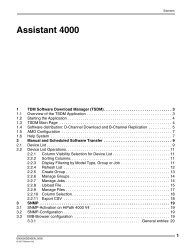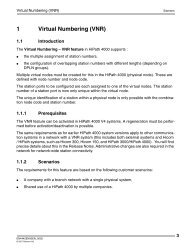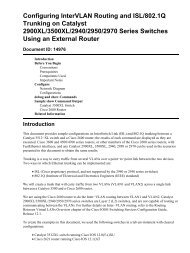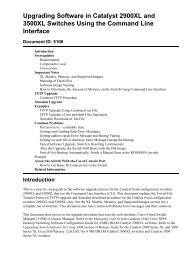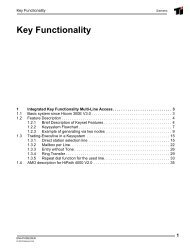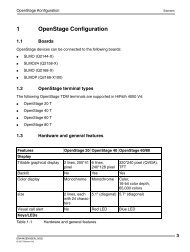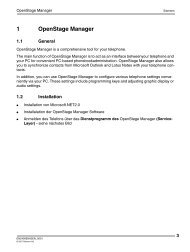Create successful ePaper yourself
Turn your PDF publications into a flip-book with our unique Google optimized e-Paper software.
Creating and Naming Static VLANs<strong>set</strong> <strong>vlan</strong> nameSyntaxThis command <strong>set</strong>s or changes the ASCII name for a new or existing VLAN.<strong>set</strong> <strong>vlan</strong> name <strong>vlan</strong>-id stringParameters<strong>vlan</strong>‐idstringValid values are 1‐4094. Each <strong>vlan</strong>‐id must be unique. If an existing <strong>vlan</strong>‐id isentered, the existing VLAN is modified.Specifies the string used as the name of the VLAN (1 to 32 characters).DefaultsModeNone.Exampleclear <strong>vlan</strong>SyntaxSwitch command, read‐write.This example <strong>set</strong>s the name for VLAN 7 to green:matrix-x(switch-su)-><strong>set</strong> <strong>vlan</strong> name 7 greenThis command removes a static VLAN from the list of VLANs recognized by the device.clear <strong>vlan</strong> <strong>vlan</strong>-listParameters<strong>vlan</strong>‐listSpecifies the VLAN ID of the VLAN(s) to be removed.DefaultsModeNone.ExampleSwitch command, read‐write.The following example removes a static VLAN 9 from the device’s VLAN list:matrix-x(switch-su)#clear <strong>vlan</strong> 9Matrix X Router Command Line Interface Reference Guide 14-3
Creating and Naming Static VLANsshow <strong>vlan</strong>SyntaxThis command displays existing VLANs.show <strong>vlan</strong> [static] [<strong>vlan</strong>-list]Parametersstatic<strong>vlan</strong>‐list(Optional) Displays information related to static VLANs. Static VLANs aremanually created using the <strong>set</strong> <strong>vlan</strong> create command or SNMP MIBs. Thedefault VLAN, VLAN 1, is always statically configured and can’t bedeleted. Only ports that use a specified VLAN as their default VLAN(PVID) will be displayed.(Optional) Displays information for a specific VLAN or range of VLANs.DefaultsModeExample• If static is not specified, information for static and dynamic VLANs will be displayed.• If <strong>vlan</strong>‐list is not specified, information for all VLANs will be displayed.Switch command, read‐only.The following example shows the output of this command.matrix-x(switch-su)-> show <strong>vlan</strong> staticVLAN: 1 NAME: DEFAULT VLAN Status: EnabledVLAN Type: Permanent FID: 1Creation Time: 0 days 1 hours 58 minutes 58 seconds agoEgress PortsNone.Forbidden Egress PortsNone.Untagged PortsNone.14-4 802.1Q VLAN Commands
Assigning Port VLAN IDs (PVIDs) and Ingress FilteringAssigning Port VLAN IDs (PVIDs) and Ingress FilteringAbout PVIDs and Policy Classification to a VLANPort VLAN IDs (PVIDs) assign VLAN IDs to untagged frames on one or more ports. Using the <strong>set</strong>port <strong>vlan</strong> command, you can, for example, assign ports 1, 5, 8, and 9 to VLAN 3. Untagged framesreceived on those ports will be assigned to VLAN 3. (By default, all ports are members of VLANID 1, the default VLAN.)Policy classification to a VLAN takes precedence over PVID assignment if:• Policy classification is configured to a VLAN and• PVID override has been enabled for a policy profile and assigned to port(s) associated withthe PVID.PurposeThese switch‐level commands are used to assign default VLAN IDs to untagged frames on one ormore ports, to configure MIB‐II interface mapping to a VLAN, to configure VLAN ingressfiltering, and to <strong>set</strong> the frame discard mode.CommandsThe commands used to configure port VLAN IDs and ingress filtering are listed below.For information about...Refer to page...show port <strong>vlan</strong> 14-6<strong>set</strong> port <strong>vlan</strong> 14-7clear port <strong>vlan</strong> 14-8show <strong>vlan</strong> interface 14-9<strong>set</strong> <strong>vlan</strong> interface 14-10clear <strong>vlan</strong> interface 14-11show port ingress-filter 14-11<strong>set</strong> port ingress-filter 14-12show port discard 14-13<strong>set</strong> port discard 14-14clear port discard 14-14Matrix X Router Command Line Interface Reference Guide 14-5
Assigning Port VLAN IDs (PVIDs) and Ingress Filteringshow port <strong>vlan</strong>SyntaxThis command displays port VLAN identifier (PVID) information. PVID determines the VLAN towhich all untagged frames received on one or more ports will be classified.show port <strong>vlan</strong> [port-string]Parametersport‐string(Optional) Displays PVID information for specific port(s).DefaultsModeExampleIf port ‐string is not specified, port VLAN information for all ports will be displayed.Switch command, read‐only.The following example displays PVIDs assigned to Gigabit Ethernet ports 1 through 6 in slot 5. Inthis case, untagged frames received on these ports will be classified to VLAN 1:matrix-x(switch-su)#show port <strong>vlan</strong> ge.5.1-6ge.5.1 is <strong>set</strong> to 1ge.5.2 is <strong>set</strong> to 1ge.5.3 is <strong>set</strong> to 1ge.5.4 is <strong>set</strong> to 1ge.5.5 is <strong>set</strong> to 1ge.5.6 is <strong>set</strong> to 114-6 802.1Q VLAN Commands
Assigning Port VLAN IDs (PVIDs) and Ingress Filtering<strong>set</strong> port <strong>vlan</strong>SyntaxThis command configures the PVID (port VLAN identifier) for one or more ports.<strong>set</strong> port <strong>vlan</strong> port-string pvidParametersport‐stringpvidSpecifies the port(s) for which to configure a VLAN identifier.Specifies the VLAN ID of the VLAN to which port(s) will be added.DefaultsModeUsageNone.Switch command, read‐write.The PVID is used to classify untagged frames as they ingress into a given port. If the specifiedVLAN has not already been created, this command will create it, add the VLAN to the port’s<strong>egress</strong> list as untagged, and remove the default VLAN from the port’s <strong>egress</strong> list.ExampleThe following example adds Gigabit Ethernet port 10 in slot 1 to the port VLAN list of VLAN 4(PVID 4). Since VLAN 4 is a new VLAN, it is created. Then port ge.1.10 is added to VLAN 4’suntagged <strong>egress</strong> list, and is cleared from the <strong>egress</strong> list of VLAN 1 (the default VLAN):matrix-x(switch-su)#<strong>set</strong> port <strong>vlan</strong> ge.1.10 4matrix-x(switch-su)#<strong>set</strong> <strong>vlan</strong> 4 creatematrix-x(switch-su)#<strong>set</strong> <strong>vlan</strong> <strong>egress</strong> 4 ge.1.10 untaggedmatrix-x(switch-su)#clear <strong>vlan</strong> <strong>egress</strong> 1 ge.1.10Matrix X Router Command Line Interface Reference Guide 14-7
Assigning Port VLAN IDs (PVIDs) and Ingress Filteringclear port <strong>vlan</strong>SyntaxThis command re<strong>set</strong>s a port’s 802.1Q port VLAN ID (PVID) to the host VLAN ID 1.clear port <strong>vlan</strong> port-stringParametersDefaultsModeNone.Exampleport‐string Specifies the port(s) to be re<strong>set</strong> to the host VLAN ID 1.Switch command, read‐write.The following example re<strong>set</strong>s the Gigabit Ethernet ports 3 and 11 in slot 1 to a VLAN ID of 1 (HostVLAN):matrix-x(switch-su)#clear port <strong>vlan</strong> ge.1.3,ge.1.1114-8 802.1Q VLAN Commands
Assigning Port VLAN IDs (PVIDs) and Ingress Filteringshow <strong>vlan</strong> interfaceSyntaxThis command displays the MIB‐II interface entry mapped to a VLAN.show <strong>vlan</strong> interface [<strong>vlan</strong>-list]Parameters<strong>vlan</strong>‐listDisplays the MIB2 interface entry for specific VLAN(s).DefaultsModeExampleIf <strong>vlan</strong>‐list is not specified, MIB2 interface entries will be displayed for all VLANs.Switch command, read‐only.This example displays the interface entry for VLAN 1:matrix-x(switch-su)#show <strong>vlan</strong> interface 1VLAN Port Storage Type-------------------------------------1 <strong>vlan</strong>.0.1 non-volatileThe following table provides an explanation of the command output.OutputVLANPortStorage TypeWhat It Displays...VLAN ID.Port-string designation.Whether the entry is stored as a volatile or non-volatile entry. Volatile entries arelost when a system is re<strong>set</strong>. Non-volatile entries are saved in NVRAM and arepersistent until cleared.Matrix X Router Command Line Interface Reference Guide 14-9
Assigning Port VLAN IDs (PVIDs) and Ingress Filtering<strong>set</strong> <strong>vlan</strong> interfaceSyntaxThis command creates, disables or enables a MIB‐II interface mapped to a VLAN.<strong>set</strong> <strong>vlan</strong> interface <strong>vlan</strong>-list {create | disable | enable} [volatile]Parameters<strong>vlan</strong>‐listcreate | disable |enablevolatileSpecifies the VLAN(s) for which an interface entry will be created,disabled or enabled.Creates, disables or enables an interface entry.(Optional) When the create keyword is used, stores the entry as a volatileentry. Volatile entries are lost when a system is re<strong>set</strong>. Non‐volatile entriesare saved in NVRAM and are persistent until cleared.DefaultsModeExampleIf volatile is not specified, entries will be created as nonvolatile.Switch command, read‐write.This example creates a volatile interface entry mapped to VLAN 1:matrix-x(switch-su)#<strong>set</strong> <strong>vlan</strong> interface 1 volatile14-10 802.1Q VLAN Commands
Assigning Port VLAN IDs (PVIDs) and Ingress Filteringclear <strong>vlan</strong> interfaceSyntaxThis command clears the MIB‐II interface entry mapped to a VLAN.clear <strong>vlan</strong> interface <strong>vlan</strong>-listParameters<strong>vlan</strong>‐listSpecifies the VLAN(s) for which an interface entry will be cleared.DefaultsModeNone.ExampleSwitch command, read‐write.This example clears the interface entry mapped to VLAN 1:matrix-x(switch-su)#clear <strong>vlan</strong> interface 1show port ingress-filterSyntaxThis command shows all ports that are enabled for port ingress filtering, which limits incomingVLAN ID frames according to a port VLAN <strong>egress</strong> list. If the VLAN ID specified in the receivedframe is not on the port’s VLAN <strong>egress</strong> list, then that frame is dropped and not forwarded.show port ingress-filter [port-string]Parametersport‐string(Optional) Specifies the port(s) for which to display ingress filtering status.DefaultsModeExampleIf port‐string is not specified, ingress filtering status for all ports will be displayed.Switch command, read‐only.This example displays the port ingress filter status for Gigabit Ethernet ports 10 through 15 in slot1. In this case, the ports are disabled for ingress filtering:matrix-x(switch-su)#show port ingress-filter ge.1.10-15Port State-------- ---------Matrix X Router Command Line Interface Reference Guide 14-11
Assigning Port VLAN IDs (PVIDs) and Ingress Filteringge.1.10 disabledge.1.11 disabledge.1.12 disabledge.1.13 disabledge.1.14 disabledge.1.15 disabled<strong>set</strong> port ingress-filterSyntaxThis command discards all frames received with a VLAN ID that do not match the port’s VLAN<strong>egress</strong> list.<strong>set</strong> port ingress-filter port-string {disable | enable}Parametersport‐stringdisable | enableSpecifies the port(s) on which to enable of disable ingress filtering.Disables or enables ingress filtering.DefaultsModeUsageNone.Switch command, read‐write.When ingress filtering is enabled on a port, the VLAN IDs of incoming frames are compared to theport’s <strong>egress</strong> list. If the received VLAN ID does not match a VLAN ID on the port’s <strong>egress</strong> list,then the frame is dropped.Ingress filtering is implemented according to the IEEE 802.1Q standard.ExampleThis example enables port ingress filtering on Gigabit Ethernet port 3 in slot 1:matrix-x(switch-su)#<strong>set</strong> port ingress-filter ge.1.3 enable14-12 802.1Q VLAN Commands
Assigning Port VLAN IDs (PVIDs) and Ingress Filteringshow port discardSyntaxThis command displays the frame discard mode for one or more ports. Ports can be <strong>set</strong> to discardframes based on whether or not they contain a VLAN tag. They can also be <strong>set</strong> to discard bothframe types or none of the frames received.show port discard [port-string]Parametersport‐string(Optional) Displays the frame discard mode for specific port(s).DefaultsModeExampleIf port‐string is not specified, frame discarded mode will be displayed for all ports.Switch command, read‐only.The following example displays the frame discard mode for Gigabit Ethernet port 7 in slot 5. Inthis case, the port has been <strong>set</strong> to discard all tagged frames:matrix-x(switch-su)#show port discard ge.5.7PortDiscard Mode------------ -------------ge.5.7taggedMatrix X Router Command Line Interface Reference Guide 14-13
Assigning Port VLAN IDs (PVIDs) and Ingress Filtering<strong>set</strong> port discardSyntaxThis command <strong>set</strong>s the frame discard mode on one or more ports.<strong>set</strong> port discard port-string {tagged | untagged | none | both}Parametersport‐stringtagged | untagged| none | bothSpecifies the port(s) for which to <strong>set</strong> frame discard mode.Sets the port(s) to discard tagged or untagged frames, no frames, or bothtypes of frames.DefaultsModeExampleclear port discardSyntaxBy default, no frames are discarded based on received format.Switch command, read‐write.This example <strong>set</strong>s Gigabit Ethernet port 7 in slot 5 to discard both tagged and untagged frames:matrix-x(switch-su)#<strong>set</strong> port discard ge.5.7 bothThis command re<strong>set</strong>s the frame discard mode to the factory default <strong>set</strong>ting (none).clear port discard port-stringParametersport‐stringSpecifies the port(s) for which to re<strong>set</strong> frame discard mode.DefaultsModeNone.ExampleSwitch command, read‐write.This example re<strong>set</strong>s Gigabit Ethernet port 7 in slot 5 to the default discard mode of “none”:matrix-x(switch-su)# clear port discard ge.5.714-14 802.1Q VLAN Commands
Configuring the VLAN Egress ListConfiguring the VLAN Egress ListPurposeSwitch commands are used to assign or remove ports on the <strong>egress</strong> list of a particular VLAN. Thisdetermines which ports will be eligible to transmit frames for a particular VLAN. For example,ports 1, 5, 9, 8 could be assigned to transmit frames belonging to VLAN 5 (VLAN ID=5).The port <strong>egress</strong> type for all ports defaults to tagging transmitted frames, but can be changed toforbidden or untagged. In general, VLANs have no <strong>egress</strong> (except for VLAN 1) until they areconfigured by static administration, or through dynamic mechanisms (that is, GVRP, policyclassification or Enterasys dynamic <strong>egress</strong>).Setting a port to forbidden prevents it from participating in the specified VLAN and ensures thatany dynamic requests (either through GVRP or dynamic <strong>egress</strong>) for the port to join the VLAN willbe ignored. Setting a port to untagged allows it to transmit frames without a tag header. This<strong>set</strong>ting is usually used to configure a port connected to an end user device.The default VLAN defaults its <strong>egress</strong> to untagged for all ports.CommandsThe commands used to configure VLAN <strong>egress</strong> and dynamic VLAN <strong>egress</strong> are listed below.For information about...Refer to page...<strong>set</strong> <strong>vlan</strong> <strong>egress</strong> 14-16clear <strong>vlan</strong> <strong>egress</strong> 14-17show <strong>vlan</strong> dynamic<strong>egress</strong> 14-18<strong>set</strong> <strong>vlan</strong> dynamic<strong>egress</strong> 14-19Matrix X Router Command Line Interface Reference Guide 14-15
Configuring the VLAN Egress List<strong>set</strong> <strong>vlan</strong> <strong>egress</strong>SyntaxThis command adds ports to the VLAN <strong>egress</strong> list for the device, or prevents one or more portsfrom participating in a VLAN. This determines which ports will transmit frames for a particularVLAN.<strong>set</strong> <strong>vlan</strong> <strong>egress</strong> <strong>vlan</strong>-list port-string [untagged | forbidden | tagged]Parameters<strong>vlan</strong>‐listport‐stringuntagged |forbidden |taggedSpecifies the VLAN where a port(s) will be added to the <strong>egress</strong> list.Specifies one or more ports to add to the VLAN <strong>egress</strong> list of the specified<strong>vlan</strong>‐list.(Optional) Adds the specified ports as:• untagged — Causes the port(s) to transmit frames without an IEEE802.1Q header tag.• forbidden — Instructs the device to ignore dynamic requests (eitherthrough GVRP or dynamic <strong>egress</strong>) from the port(s) to join the VLANand disallows <strong>egress</strong> on that port.• tagged — Causes the port(s) to transmit 802.1Q tagged frames.DefaultsModeIf untagged, forbidden or tagged is not specified, the port will be added to the VLAN <strong>egress</strong> listas tagged.Switch command, read‐write.ExamplesThe following example adds Gigabit Ethernet ports 5 through 10 in slot 1 to the <strong>egress</strong> list ofVLAN 7. This means that these ports will transmit VLAN 7 frames as tagged:matrix-x(switch-su)# <strong>set</strong> <strong>vlan</strong> <strong>egress</strong> 7 ge.1.5-10The following example forbids Gigabit Ethernet ports 13 through 15 in slot 1 from joining VLAN 7and disallow <strong>egress</strong> on those ports:matrix-x(switch-su)# <strong>set</strong> <strong>vlan</strong> <strong>egress</strong> 7 ge.1.13-15 forbiddenThe following example allows Gigabit Ethernet port 2 in slot 1 to transmit VLAN 7 frames asuntagged:matrix-x(switch-su)# <strong>set</strong> <strong>vlan</strong> <strong>egress</strong> 7 ge.1.2 untagged14-16 802.1Q VLAN Commands
Configuring the VLAN Egress Listclear <strong>vlan</strong> <strong>egress</strong>SyntaxThis command removes ports from a VLAN’s <strong>egress</strong> list.clear <strong>vlan</strong> <strong>egress</strong> <strong>vlan</strong>-list port-string [forbidden]Parameters<strong>vlan</strong>‐listport‐stringforbiddenSpecifies the number of the VLAN from which a port(s) will be removedfrom the <strong>egress</strong> list.Specifies one or more ports to be removed from the VLAN <strong>egress</strong> list of thespecified <strong>vlan</strong>‐list.(Optional) Clears the forbidden <strong>set</strong>ting from the specified port(s) and re<strong>set</strong>sthe port(s) as able to <strong>egress</strong> frames if so configured by either static ordynamic means.DefaultsModeIf forbidden is not specified, tagged and untagged <strong>set</strong>tings will be cleared.Switch command, read‐write.ExamplesThe following example removes Gigabit Ethernet port 1 in slot 3 from the <strong>egress</strong> list of VLAN 9:matrix-x(switch-su)# clear <strong>vlan</strong> <strong>egress</strong> 9 ge.3.1The following example removes all Gigabit Ethernet ports in slot 2 from the <strong>egress</strong> list of VLAN 4:matrix-x(switch-su)# clear <strong>vlan</strong> <strong>egress</strong> 4 ge.2.*Matrix X Router Command Line Interface Reference Guide 14-17
Configuring the VLAN Egress Listshow <strong>vlan</strong> dynamic<strong>egress</strong>SyntaxThis command displays which VLANs are currently enabled for VLAN dynamic <strong>egress</strong>.show <strong>vlan</strong> dynamic<strong>egress</strong> [<strong>vlan</strong>-list]Parameters<strong>vlan</strong>‐list(Optional) Displays dynamic <strong>egress</strong> status for specific VLAN(s).DefaultsModeExampleIf <strong>vlan</strong>‐list is not specified, status for all VLANs where dynamic <strong>egress</strong> is enabled will bedisplayed.Switch command, read‐only.The following example displays which VLANs are enabled for dynamic <strong>egress</strong>:matrix-x(switch-su)# show <strong>vlan</strong> dynamic<strong>egress</strong>VLAN 1 is enabledVLAN 101 is enabledVLAN 102 is enabledVLAN 105 is enabled14-18 802.1Q VLAN Commands
Configuring the VLAN Egress List<strong>set</strong> <strong>vlan</strong> dynamic<strong>egress</strong>SyntaxThis command <strong>set</strong>s the administrative status of one or more VLANs’ dynamic <strong>egress</strong> capability. IfVLAN dynamic <strong>egress</strong> is enabled, the device will add the port receiving a tagged frame to theVLAN <strong>egress</strong> list of the port according to the frame VLAN ID.<strong>set</strong> <strong>vlan</strong> dynamic<strong>egress</strong> <strong>vlan</strong>-list {enable | disable}Parameters<strong>vlan</strong>‐listenable | disableSpecifies the number of the VLAN(s) where dynamic <strong>egress</strong> will beenabled or disabled.Enables or disables dynamic <strong>egress</strong>.DefaultsModeNone.ExampleSwitch command, read‐write.The following example enables the dynamic <strong>egress</strong> function on VLAN 7:matrix-x(switch-su)# <strong>set</strong> <strong>vlan</strong> dynamic<strong>egress</strong> 7 enableMatrix X Router Command Line Interface Reference Guide 14-19
Enabling/Disabling GVRP (GARP VLAN Registration Protocol)Enabling/Disabling GVRP (GARP VLAN Registration Protocol)PurposeThese switch‐level commands are used to dynamically create VLANs across a switched network.The GVRP command <strong>set</strong> is used to display GVRP configuration information, the current globalGVRP state <strong>set</strong>ting, individual port <strong>set</strong>tings (enable or disable) and timer <strong>set</strong>tings. By default,GVRP is enabled on all ports, and globally on the device.CommandsThe commands used to configure GVRP are listed below.For information about...Refer to page...show gvrp 14-20show garp timer 14-21<strong>set</strong> gvrp 14-22clear gvrp 14-23<strong>set</strong> garp timer 14-23clear garp timer 14-24show gvrpSyntaxThis command displays GVRP configuration information.show gvrp [port-string]Parametersport-string(Optional) Displays GVRP configuration information for specific port(s).DefaultsModeIf port‐string is not specified, GVRP configuration data is displayed for all ports and the device.Switch command, read‐only.14-20 802.1Q VLAN Commands
ExampleEnabling/Disabling GVRP (GARP VLAN Registration Protocol)The following example displays GVRP status for the device and Gigabit Ethernet port 1 in slot 7:matrix-x(switch-su)# show gvrp ge.7.1Global GVRP status is enabled.Port Number GVRP status Last PDU Origin----------- ----------- -----------------ge.7.1 enabled 00-e0-63-97-d4-36The following table describes the output.OutputPort NumberGVRP statusLast PDU OriginWhat It DisplaysPort designation.Whether GVRP is enabled or disabled on the port.MAC address of the last GVRP frame received on the portshow garp timerSyntaxThis command displays Group Address Registration Protocol (GARP) timer values for one ormore ports.show garp timer [port-string]Parametersport‐string(Optional) Displays GARP timer data for specific port(s).DefaultsModeExampleIf port‐string is not specified, GARP timer information will be displayed for all ports.Switch command, read‐only.The following example displays GARP timer data on Gigabit Ethernet ports 1 through 10 in slot 1:matrix-x(switch-su)# show garp timer ge.1.1-10Port based GARP Configuration: (Timer units are centiseconds)Port Number Join Leave Leaveall----------- ----- ------- --------ge.1.1 20 60 1000ge.1.2 20 60 1000ge.1.3 20 60 1000ge.1.4 20 60 1000ge.1.5 20 60 1000ge.1.6 20 60 1000ge.1.7 20 60 1000Matrix X Router Command Line Interface Reference Guide 14-21
Enabling/Disabling GVRP (GARP VLAN Registration Protocol)ge.1.8 20 60 1000ge.1.9 20 60 1000ge.1.10 20 60 1000The table below describes the command output. See <strong>set</strong> gvrp for details on enabling or disablingGVRP. See <strong>set</strong> garp timer for details on changing default timer values.OutputPort NumberJoinLeaveLeaveallWhat It DisplaysPort designation. For a detailed description of possible port-string values, referto Port Strings Used in the CLI on page 7-2.Join timer <strong>set</strong>ting.Leave timer <strong>set</strong>ting.Leavall timer <strong>set</strong>ting.Note: For a functional description of the terms join, leave, and leaveall timers, refer to standardIEEE 802.1Q documentation, which is not supplied with this device.<strong>set</strong> gvrpSyntaxThis command enables or disables GVRP globally on the device or on one or more ports.<strong>set</strong> gvrp {enable | disable} [port-string]Parametersenable | disableport‐stringDisables or enables GVRP on the device.(Optional) Disables or enables GVRP on specific port(s).DefaultsModeIf port‐string is not specified, GVRP will be disabled or enabled for all ports.Switch command, read‐write.ExamplesThe following example enables GVRP globally on the device:matrix-x(switch-su)#<strong>set</strong> gvrp enableThe following example disables GVRP globally on the device:matrix-x(switch-su)#<strong>set</strong> gvrp disableThe following example enables GVRP on Gigabit Ethernet port 3 in slot 1:matrix-x(switch-su)#<strong>set</strong> gvrp enable ge.1.314-22 802.1Q VLAN Commands
Enabling/Disabling GVRP (GARP VLAN Registration Protocol)clear gvrpSyntaxThis command clears GVRP status or on one or more ports.clear gvrp [port-string]Parametersport‐string(Optional) Clears GVRP status on specific port(s).DefaultsModeExample<strong>set</strong> garp timerSyntaxIf port‐string is not specified, GVRP status will be cleared for all ports.Switch command, read‐write.The following example clears GVRP status globally on the device:matrix-x(switch-su)#clear gvrpThis command adjusts the values of the join, leave, and leave all timers.<strong>set</strong> garp timer {[join timer-value][leave timer-value][leaveall timer-value]}port-stringParametersDefaultsjoin timer‐value Sets the GARP join timer in centiseconds. The value can range from 1to 2147483647 centiseconds. Default is 20.leave timer‐valueleaveall timer‐valueport‐string• Join 20 centiseconds• Leave 60 centiseconds• Leaveall 1000 centisecondsSets the GARP leave timer in centiseconds. The value can range from1 to 2147483647 centiseconds. Default is 60.Sets the GARP leaveall timer in centiseconds. The value can rangefrom 1 to 2147483647 centiseconds. Default is 1000.Specifies the port(s) on which to configure GARP timer <strong>set</strong>tings. For adetailed description of possible port‐string values, refer to Port StringsUsed in the CLI on page 7‐2.Matrix X Router Command Line Interface Reference Guide 14-23
Enabling/Disabling GVRP (GARP VLAN Registration Protocol)ModeUsageSwitch command, read‐write.The <strong>set</strong>ting of these timers is critical and should only be changed by personnel familiar with the802.1Q standards documentation, which is not supplied with this device.ExamplesThe following example <strong>set</strong>s the GARP join timer value to 100 centiseconds for all ports:matrix-x(switch-su)#<strong>set</strong> garp timer join 100 *.*.*The following example <strong>set</strong>s the leave timer value to 300 centiseconds for all ports:matrix-x(switch-su)#<strong>set</strong> garp timer leave 300 *.*.*The following example <strong>set</strong>s the leaveall timer value to 20000 centiseconds for all ports:matrix-x(switch-su)#<strong>set</strong> garp timer leaveall 20000 *.*.*clear garp timerThis command re<strong>set</strong>s GARP timers to default values.Syntaxclear garp timer {[join] [leave] [leaveall]} port-stringParametersjoinleaveleaveallport‐string(Optional) Re<strong>set</strong>s the join timer to 20 centiseconds.(Optional) Re<strong>set</strong>s the leave timer to 60 centiseconds.(Optional) Re<strong>set</strong>s the leaveall timer to 1000 centiseconds.Specifies the port(s) on which to re<strong>set</strong> GARP timer(s).DefaultsModeExampleAt least one optional parameter must be entered.Switch command, read‐write.The following example re<strong>set</strong>s the GARP leave timer to 60 centiseconds on Gigabit Ethernet port 3in slot 5:matrix-x(switch-su)#clear garp timer leave ge.5.314-24 802.1Q VLAN Commands



